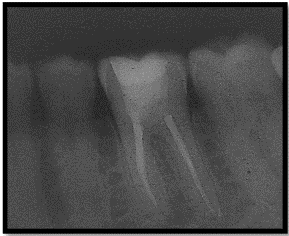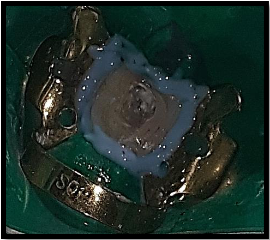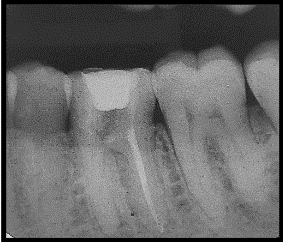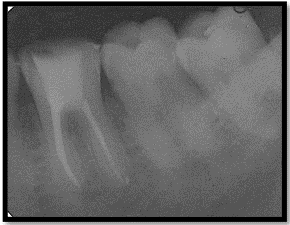Krish Chopra*
Consultant Endodontist and Senior Lecturer, FMS Dental Hospitals and Sri Sai College of Dental Surgery, India
*Corresponding Author: Krish Chopra, Consultant Endodontist and Senior Lecturer, FMS Dental Hospitals and Sri Sai College of Dental Surgery, India.
Received: August 07, 2024; Published: August 27, 2024
Citation: Krish Chopra. “Selective Endodontic Retreatment of a Mandibular Molar: A Case Report". Acta Scientific Dental Sciences 8.9 (2024):75-77.
Endodontic Retreatment is a procedure that is performed on a previously attempted failed root canal treatment. It involves the removal of gutta percha from the canals followed by proper chemo mechanical debridement and obturation. Lack of healing or persistence of symptoms post treatment indicates a shortcoming in the treatment protocol followed. When localized evidence of peri radicular pathology exists which may be limited to one root, selective endodontic retreatment may be preferred as it provides for an orthograde, conservative and minimally invasive approach.
Keywords: Selective Endodontic Retreatment; Post Treatment Apical Periodontitis; Chemo Mechanical Debridement
Post-treatment apical periodontitis is caused by either persistent or secondary intra-radicular infection. Improper chemo mechanical debridement of the canals may be one of the reasons for failed treatment [1]. Conventionally, nonsurgical retreatment is an ‘‘all or none’’ treatment approach which may involve excessive removal of dentin and affect structure the prognosis of the tooth [2,3]. Selective endodontic retreatment involves intervention of the diseased roots only without involving the ‘healthy’ ones. Localised evidence of peri radicular pathology around the ‘diseased roots’ is one such indication for selective retreatment [4]. Although concerns have been raised regarding the effectiveness of selective retreatment procedures, it provides for an orthograde, conservative and minimally invasive treatment approach. Obturations that are short of the apex may also show evidence of localised peri radicular pathology which may warrant retreatment [5]. Inadequate chemo mechanical debridement of the canals in case of short obturations may attribute to the development of peri apical lesions/post treatment apical periodontitis.
In the present literature, evidence regarding selective retreatment is controversial. The following case report adopts this treatment approach in a mandibular molar.
A 45-year-old female patient reported to the Department of Conservative Dentistry and Endodontics with a chief complaint of pain in the lower right back tooth region since 1 month. The patient did not exhibit any relevant medical history, however she gave a past dental history of root canal treatment on her lower right back tooth which was performed 2 years ago. Clinical examination revealed tooth no 46 which was tender on percussion, no pain on palpation, no mobility, no cracks/fractures, good post endodontic restoration and normal probing depth. A radiograph was advised for the same. IOPA revealed the presence of well obturated distal canals with mesial canals that were obturated 2mm short of the apex with localised radiolucency around the mesial roots. Hence a diagnosis of post treatment apical periodontitis was made and the treatment plan involved selective retreatment of the mesial canals.
Informed consent was taken from the patient and rubber dam was placed WRT tooth no 46, the post endodontic restoration was removed with the help of a high speed handpiece and round burr until the orifices of the mesial canals were visible. A gutta percha solvent was placed over the mesial orifices and the gutta percha was removed the help of Dentsply retreatment rotary files. Apical 2mm was negotiated with the help of a no 10 K file and EDTA gel (RC Prep), the working length was determined using radiographic method and both the mesiobuccal and mesiolingual canals were prepared till F2 using Protaper Gold rotary files. The canals were irrigated with 5.25% sodium hypochlorite and sterile saline solution during instrumentation. An intracanal medicament of freshly mixed calcium hydroxide paste was placed in both the canals with the help of a lentulospiral, which was replaced after 7-10 days. A total of 4 intracanal medicament changes were done. Prior to obturation ,the canals were irrigated with 17% EDTA to remove the smear layer followed by a final rinse of 2% Chlorhexidine solution. The canals were obturated with F2 gutta percha and AH plus sealer using single cone technique. Post endodontic restoration was done with composite.

Figure 1: Pre-Operative Radiograph.

Figure 2: Rubber dam isolation.

Figure 3: After Gutta Percha removal.

Figure 4: Post Operative Radiograph.
In the present literature there are very few conservative treatment options for teeth with persisting pathologies.
Selective endodontic retreatment has proven to be one such ‘minimally invasive’ treatment modality.
In a recent study Martins et al concluded that selective endodontic retreatment provides for a successful treatment outcome with a survival rate of 91.8% at 12-48 months [6].
The selective retreatment of roots with apical periodontitis can be another viable form of conservative treatment in endodontics when well indicated in cases where there is no exposure of the filling material and the retreatment of all roots can cause the risk of weakening the tooth structure and tooth loss [7].
According to Nudera et al, the failure rate of conventional and selective retreatment is comparable (13.6) at 3 years and hence selective retreatment presents as a good treatment option [8]. A few retrospective studies have ascertained a success rate of 86% for selective endodontic procedures as well.In case of post treatment apical periodontitis where the obturations are visibly short of the apex, incomplete debridement ,cleaning and shaping of the canals could be a contributing factor [9].
In such cases, retreatment is the suitable treatment option and the protocol adopted should be aimed at resolution of the existing peri radicular pathology/persistent symptoms if any.
However, careful treatment planning and case selection is of utmost important when planning selective retreatment.
Operator skill is also a major factor which influences the outcome of the procedure.
Selective retreatment is beneficial f from a biological point of view, being minimally invasive and with reduced risks of iatrogenic mishaps, but also in terms of time and costs, being equally effective clinically as a complete retreatment.
Selective endodontic retreatment is a suitable treatment option to deal with localised pathologies/pathologies that are only limited to ‘diseases’ roots. However, the current literature regarding the adoption of the said procedure is controversial and further studies are required in order to help the clinician make an informed decision.
The author reports no conflict of interest.
Copyright: © 2024 Krish Chopra. This is an open-access article distributed under the terms of the Creative Commons Attribution License, which permits unrestricted use, distribution, and reproduction in any medium, provided the original author and source are credited.
ff
© 2024 Acta Scientific, All rights reserved.